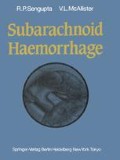Abstract
The role of surgery for intracranial aneurysms is usually preventive. From the natural history of ruptured aneurysms, it is well recognised that life or neurological function may be further threatened by a recurrent haemorrhage from the aneurysm. The risk of rebleeding is most frequent in the first 2 weeks after the initial bleed, but remains for the rest of the patient’s life to a variable degree. Surgical obliteration of the aneurysm after the first haemorrhage is the best way to prevent a recurrent bleed. However, the surgical treatment of an intracranial aneurysm is a formidable measure, with a potential risk of mortality and morbidity. When the brain has already been injured by the SAH, the risk of complication from surgical intervention is proportionately high. The role of aneurysm surgery must, therefore, be considered in terms of its effectiveness, its complications and the natural history of the aneurysm.
Access this chapter
Tax calculation will be finalised at checkout
Purchases are for personal use only
Preview
Unable to display preview. Download preview PDF.
References
Bailey WL, Loeser JD (1971) Intracranial aneurysms. JAMA 216:1993–1996
Debrun G, Lacour B, Caron JP et al. (1978) Detachable balloon and calibrated-leak balloon techniques in the treatment of cerebral vascular lesions. J Neurosurg 49:635–649
Dott NM (1933) Intracranial aneurysms: cerebral arterio- radiography surgical treatment. Edin Med J 40:219–240
Drake CG (1975) Ligation of the vertebral (unilateral or bilateral) or basilar artery in the treatment of large intracranial aneurysms. J Neurosurg 43:255–274
Drake CG (1979) Giant intracranial aneurysms: Experience with surgical treatment in 174 patients. Clin Neurosurg 26:12–95
Falconer MA (1951) The surgical treatment of bleeding intracranial aneurysms. J Neurol Neurosurg Psychiatry 14:143–186
Fox JL (1978) Intracranial aneurysms: intracranial and intraspinal arterio-venous malformations. Neurosurgery 3:305–320
Gillingham FJ (1967) The management of ruptured intracranial aneurysms. Scott Med J 12:377–383
Gillingham FJ (1975) Twenty-five years experience with middle cerebral aneurysms. J Neurol Neurosurg Psychiatry 38:404–413
Hamby WB (1952) Intracranial aneurysms. Charles C. Thomas, Springfield, Ill., pp 321–339
Hori S, Suzuki J (1979) Early intracranial operations for ruptured aneurysms. Acta Neurochir 46:93–104
Hunt WE, Miller CA (1977) The results of early operation for aneurysm. Clin Neurosurg 24:208–215
Kempe L (1968) Operative neurosurgery, vol 1. Cranial, cerebral and intracranial vascular diseases. Springer, Berlin Heidelberg, New York, pp 22–75
Kirgis HD, Llewellyn RC, Peebles EM (1960) Functional trifurcation of the internal carotid artery and its potential clinical significance. J Neurosurg 17:1062–1072
Locksley HB (1966) Natural history of subarachnoid haemorrhage, intracranial aneurysms and arteriovenous malformations. J Neurosurg 25:321–368
Logue V (1956) Surgery in spontaneous subarachnoid haemorrhage. Br Med J 1:473–479
Martindale BV, Garfield J (1978) Subarachnoid haemorrhage above the age of 59. Br Med J 1:465–467
Mount LA, Brisman R (1974) Treatment of multiple intracranial aneurysms—symptomatic and asymptomatic. Clin Neurosurg 21:166–170
Mullan S (1974) Experiences with surgical thrombosis of intracranial berry aneurysms and carotid-cavernous fistula. J Neurosurg 41:657–670
Mullan S, Raimondi AJ, Dobson G, Vailati G, Hekmatpanah J (1965) Electrically induced thrombosis in intracranial aneurysms. J Neurosurg 22:539–547
Norlen G, Barnum AS (1953) Surgical treatment of aneurysms of the anterior communicating artery. J Neurosurg 10:634–650
Paterson A, Bond MR (1973) Treatment of multiple intracranial arterial aneurysms. Lancet 1:1302–1304
Pool JL (1961) Aneurysms of the anterior communicating artery. Bifrontal craniotomy and routine use of temporary clips. J Neurosurg 18:98–111
Romodanov AP, Shcheglov VI (1979) Endovascular method of excluding from the circulation saccular cerebral arterial aneurysms, leaving intact vessels patent. Acta Neurochir 28:312–315
Sano K, Saito I (1978) Timing and indication of surgery for ruptured intracranial aneurysms with regard to cerebral vasospasm. Acta Neurochir 41:49–60
Schmidek HH, Sweet WH (1982) Operative neurosurgical technique—indication, method and result. Grune and Stratton, New York, pp 819–932
Sengupta RP (1975) Anatomical variations in the origin of the posterior cerebral artery demonstrated by carotid angiography and their significance in the direct surgical treatment of posterior communicating aneurysms. Neurochirurgia 18:33–42
Sengupta RP (1977) Anterior communicating aneurysms and their management after subarachnoid haemorrhage. M.Sc. Thesis, University of Newcastle upon Tyne
Sengupta RP (1982a) Special indications for external/internal by-pass operations. Neurosurg Rev 5:107–112
Sengupta RP (1982b) Management of large and giant aneurysms. Neurosurg Rev 5:173–178
Sengupta RP, Lassman LP (1974) Identification of the source of bleeding in multiple intracranial aneurysms. Vase Surg 8:177–183
Sengupta RP, Lassman LP, Hankinson J (1978) Scope of surgery for intracranial aneurysm in the elderly. A preliminary report. Br Med J II: 246–247
Serbinenko PB (1974) Balloon catheterisation and occlusion of major cerebral vessels. J Neurosurg 41:125–144
Spetzler RF, Schuster H, Roski RA (1980) Elective extracranial-intracranial arterial by-pass in the treatment of inoperable giant aneurysms of the internal carotid artery. J Neurosurg 53:22–27
Suzuki J, Yoshimoto T (1979) The effect of mannitol in prolongation of permissible occlusion time of cerebral artery. Clinical data of aneurysm surgery. In: Suzuki J (ed) Cerebral aneurysms. Neuron, Tokyo, pp 330–337
Symon L (1980) (ed) Neurosurgery. Rob C, Smith R (gen eds) Operative surgery, edn III. Butterworth, London, Boston, pp 225–306
Tonnis W (1936) Erfolgreiche Behandlung eines Aneurysma der Arteria communicans anterior cerebri. Zentralbl Neurochir 1:39–42
Winn HR, Almaani W, Berga S, Jane J, Richardson AE (1983) The longterm outcome in patients with multiple aneurysms. Incidence of late haemorrhage and implication for treatment in incidental aneurysms. J Neurosurg 59:642–651
Yasargil MG (1969) Microsurgery—applied to neurosurgery. Thieme, Stuttgart
Author information
Authors and Affiliations
Rights and permissions
Copyright information
© 1986 Springer-Verlag Berlin Heidelberg
About this chapter
Cite this chapter
Sengupta, R.P., McAllister, V.L. (1986). Basic Principles of Surgical Treatment of Intracranial Aneurysms. In: Subarachnoid Haemorrhage. Springer, London. https://doi.org/10.1007/978-1-4471-1383-6_10
Download citation
DOI: https://doi.org/10.1007/978-1-4471-1383-6_10
Publisher Name: Springer, London
Print ISBN: 978-1-4471-1385-0
Online ISBN: 978-1-4471-1383-6
eBook Packages: Springer Book Archive

